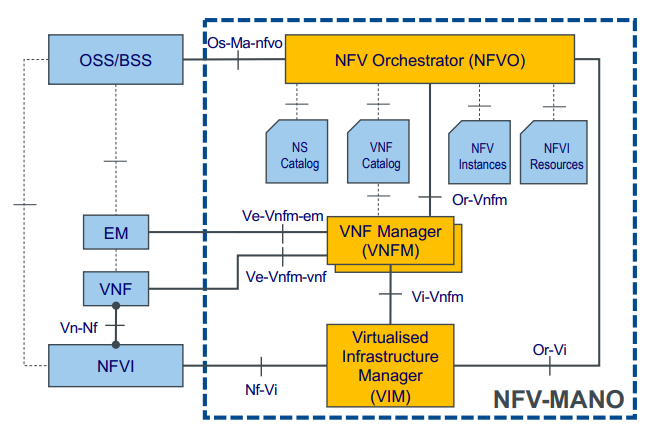NFV Architectural Framework
The architecture that defines traditional network devices is fairly basic because both the hardware and software are customized and tightly integrated. In contrast, NFV allows software developed by the vendors to run on generic shared hardware, creating multiple touch points for management.
The NFV architectural framework is developed to ensure that these touch points are standardized and compatible between the implementations of different vendors. This section provides a comprehensive discussion on the framework and the rationale behind its blocks. Understanding the framework enables readers to envision the flexibility and freedom of choice that NFV has to offer.
What is VNF?
VNF (virtualized network function) replaces a vendor’s specialized hardware with systems performing the same function, yet running on Commodity hardware (Commodity hardware, in an IT context, is a device or device component that is relatively inexpensive, widely available and more or less interchangeable with other hardware of its type).
ETSI Framework for NFV
European Telecommunications Standards Institute (ETSI) formally started in early 2013, working towards defining requirements and an architectural framework to support the virtualized implementation of network functions performed by custom hardware devices from vendors.
ETSI Recommendation:
- Decoupling: complete separation of hardware and software.
- Flexibility: automated and scalable deployment of the network functions.
- Dynamic operations: control of the operational parameters of the network functions through granular control and monitoring of the state of the network.
High-Level ETSI NFV Framework
The architectural framework forms the basis of the standardization and development work and is commonly referred to as the ETSI NFV framework. At a high level, the framework encompasses the management of VNFs, relationships and interdependencies, data flow between VNFs, and resource allocation. ETSI ISG (Internet specification group) categorized these roles into three high-level blocks, namely the infrastructure block, virtualized functions block, and management block.

In ETSI’s definition, the formal names of these blocks are defined as:
-
Network Functions Virtualization Infrastructure (NFVI) block: This block forms the foundation of the overall architecture. The hardware to host the virtual machines, the software to make virtualization possible, and the Virtualized resources are grouped into this block.
-
Virtualized Network Function (VNF) block: The VNF block uses the virtual machines offered by NFVI and builds on top of them by adding the software implementing the virtualized network functions.
-
Management and Orchestration (MANO) block: MANO is defined as a separate block in the architecture, which interacts with both the NFVI and VNF blocks. The framework delegates to the MANO layer the management of all the resources in the infrastructure layer; in addition, this layer creates and deletes resources and manages their allocation of the VNFs.
Examples of VNFs:
- Switching: BNG, CG-NAT, routers.
- Mobile network nodes: HLR/HSS, MME, SGSN, GGSN/PDN-GW, RNC.
- Home routers and set-top boxes.
- Tunneling gateway elements.
- Traffic analysis: DPI.
- Signaling: SBCs, IMS.
- Network-wide functions: AAA servers,policy control.
- Application-level optimization: CDNs, Load Balancers.
- Security functions: Firewalls, intrusion detection systems.
References:
- ETSI.
- Network Functions Virtualization (NFV) with a Touch of SDN.
